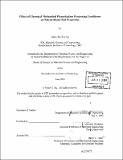| dc.contributor.advisor | David K. Roylance. | en_US |
| dc.contributor.author | Ng, Grace Siu-Yee, 1980- | en_US |
| dc.contributor.other | Massachusetts Institute of Technology. Dept. of Materials Science and Engineering. | en_US |
| dc.date.accessioned | 2009-07-01T18:47:11Z | |
| dc.date.available | 2009-07-01T18:47:11Z | |
| dc.date.copyright | 2003 | en_US |
| dc.date.issued | 2003 | en_US |
| dc.identifier.uri | http://dspace.mit.edu/handle/1721.1/43618 | en_US |
| dc.identifier.uri | http://hdl.handle.net/1721.1/43618 | |
| dc.description | Thesis (S.M.)--Massachusetts Institute of Technology, Dept. of Materials Science and Engineering, 2003. | en_US |
| dc.description | Includes bibliographical references (leaves 58-59). | en_US |
| dc.description.abstract | Chemical Mechanical Planarization (CMP) is a vital process used in the semiconductor industry to isolate and connect individual transistors on a chip. However, many of the fundamental mechanisms of the process are yet to be fully understood and defined. The difficulty in analyzing the CMP process lies in the fact that many factors, such as properties of consumables, polishing speed, polishing pressure, etc, can affect the outcome of the CMP process. This paper focuses on the thermal and mechanical properties of one of the consumables - the CMP soft pad. During the CMP process, the pad is subjected to high temperatures and chemicals from the slurry. Thus, the properties of the pad can be irreversibly changed, affecting the planarity of the resultant wafer. In this study, the CMP processing conditions were simulated in the laboratory by annealing the pad at high temperatures and soaking the pad in slurry and DIW for up to two months. The properties of the CMP pad were then measured using four thermo analytical tools - dynamic mechanical analyzer (DMA), thermo-gravimetric analyzer (TGA), thermomechanical analyzer (TMA), and modulated differential scanning calorimeter (MDSC). Results suggested that both annealing at temperatures above 140 °C and soaking in slurry for up to two weeks significantly increase the storage modulus of the sample and promote pad shrinkage in the transverse dimension. Thus, it is not recommended that the soft pad be used at operating temperatures above 140 °C and for polishing times of more than two weeks (336 hrs). | en_US |
| dc.description.statementofresponsibility | by Grace Siu-Yee Ng. | en_US |
| dc.format.extent | 59 leaves | en_US |
| dc.language.iso | eng | en_US |
| dc.publisher | Massachusetts Institute of Technology | en_US |
| dc.rights | M.I.T. theses are protected by
copyright. They may be viewed from this source for any purpose, but
reproduction or distribution in any format is prohibited without written
permission. See provided URL for inquiries about permission. | en_US |
| dc.rights.uri | http://dspace.mit.edu/handle/1721.1/43618 | en_US |
| dc.rights.uri | http://dspace.mit.edu/handle/1721.1/7582 | en_US |
| dc.subject | Materials Science and Engineering. | en_US |
| dc.title | Effect of chemical mechanical planarization processing conditions on polyurethane pad properties | en_US |
| dc.type | Thesis | en_US |
| dc.description.degree | S.M. | en_US |
| dc.contributor.department | Massachusetts Institute of Technology. Department of Materials Science and Engineering | |
| dc.identifier.oclc | 54818365 | en_US |
